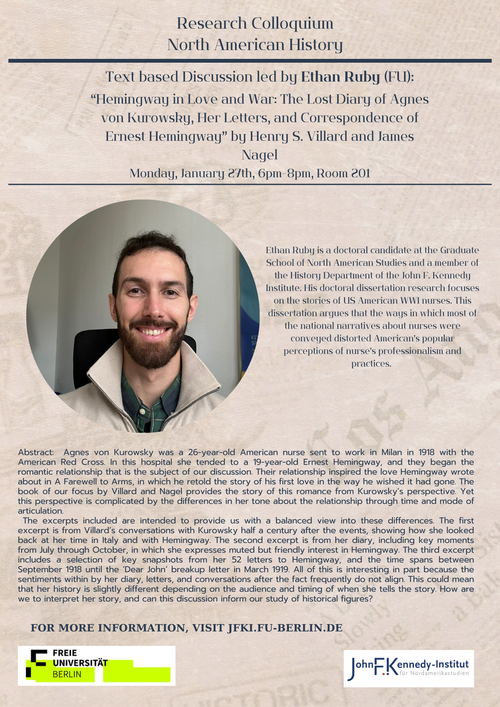Research Colloquium: Text-Based discussion led by Ethan Ruby on "Hemingway in Love and War: The Lost Diary of Agnes von Kurowsky, Her Letters, and Correspondence of Ernest Hemingway" by Henry S. Villard and James Nagel
Ethan Ruby is a doctoral candidate at the Graduate School of North American Studies and a member of the History Department of the John F. Kennedy Institute. His doctoral dissertation research focuses on the stories of US American WWI nurses. This dissertation argues that the ways in which most of the national narratives about nurses were conveyed distorted American's popular perceptions of nurse's professionalism and practices.
Abstract: Agnes von Kurowsky was a 26-year-old American nurse sent to work in Milan in 1918 with the American Red Cross. In this hospital she tended to a 19-year-old Ernest Hemingway, and they began the romantic relationship that is the subject of our discussion. Their relationship inspired the love Hemingway wrote about in A Farewell to Arms, in which he retold the story of his first love in the way he wished it had gone. The book of our focus by Villard and Nagel provides the story of this romance from Kurowsky’s perspective. Yet this perspective is complicated by the differences in her tone about the relationship through time and mode of articulation.
The excerpts included are intended to provide us with a balanced view into these differences. The first excerpt is from Villard’s conversations with Kurowsky half a century after the events, showing how she looked back at her time in Italy and with Hemingway. The second excerpt is from her diary, including key moments from July through October, in which she expresses muted but friendly interest in Hemingway. The third excerpt includes a selection of key snapshots from her 52 letters to Hemingway, and the time spans between September 1918 until the ‘Dear John’ breakup letter in March 1919. All of this is interesting in part because the sentiments within by her diary, letters, and conversations after the fact frequently do not align. This could mean that her history is slightly different depending on the audience and timing of when she tells the story. How are we to interpret her story, and can this discussion inform our study of historical figures?
For the readings, please see below.

